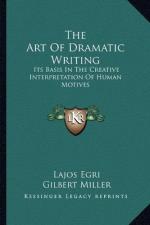
|
| Name: _________________________ | Period: ___________________ |
This test consists of 5 multiple choice questions, 5 short answer questions, and 10 short essay questions.
Multiple Choice Questions
1. What was the original title of "The Art of Dramatic Writing"?
(a) "How to Write a Play".
(b) "A Playwright's Dream".
(c) "Acting In the Modern World".
(d) "The Stage".
2. What has a reigning power in the presence of a written piece of work according to Lajos Egri?
(a) Structure.
(b) Character.
(c) Catharsis.
(d) Plot.
3. What term means a striking exhibition of unlikeness?
(a) Contrast.
(b) Obstacle.
(c) None of the answers is correct.
(d) Conflict.
4. In Book II, Character, Chapter 11: Unity of Opposites, the author asserts that characters must be what?
(a) Well-defined.
(b) Passionate.
(c) Likeable.
(d) Varied.
5. What childless widow is friends with Nora in "A Doll's House"?
(a) Christine Linde.
(b) Christine Torvald.
(c) Christine Rank.
(d) Christine Krogstad.
Short Answer Questions
1. What does Lajos Egri claim to be the premise of King Lear?
2. What term is defined by Webster's Dictionary as "a proposition antecedently supposed or proved; a basis of argument. A proposition stated or assumed as leading to a conclusion"?
3. What does Lajos Egri define as being what a writer sets out to prove with his story?
4. What must every planned sprint have, according to the author in Book I: The Premise?
5. Who is Macbeth's friend and a general in the army in "The Tragedy of Macbeth"?
Short Essay Questions
1. How does Egri view the correlation between thinking and premise?
2. What are the three dimensions the author describes as "bone structure"?
3. What example does the author give for the use of dialectics in perceiving contradictions in Book II: Character, Chapter 3: The Dialectical Approach?
4. How does Egri relate the premise to the universal truth?
5. What is the first step to fleshing out characters, according to the author?
6. What does Egri say about the writer's doubts about a character's development?
7. How does the author show the importance of character in "Oedipus Rex"?
8. What does the author claim is the one key factor in obtaining conflict?
9. How important is a character's environment to their actions?
10. What is the author's premise in opening Book II: Character, Chapter 1?
|
This section contains 874 words (approx. 3 pages at 300 words per page) |

|




